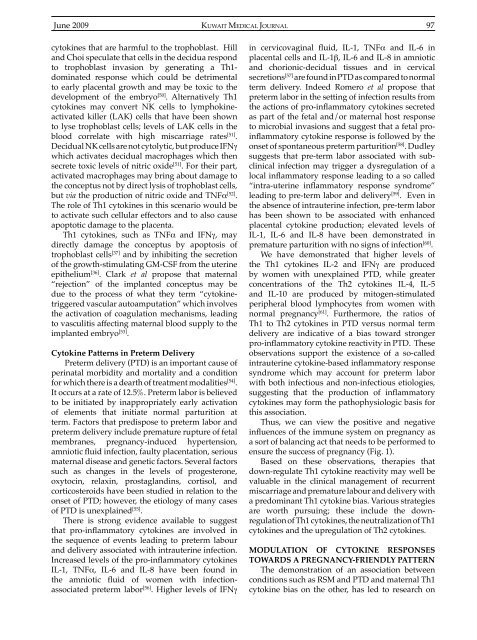June 09-41-2.indd - Kma.org.kw
June 09-41-2.indd - Kma.org.kw
June 09-41-2.indd - Kma.org.kw
Create successful ePaper yourself
Turn your PDF publications into a flip-book with our unique Google optimized e-Paper software.
<strong>June</strong> 20<strong>09</strong>KUWAIT MEDICAL JOURNAL 97cytokines that are harmful to the trophoblast. Hilland Choi speculate that cells in the decidua respondto trophoblast invasion by generating a Th1-dominated response which could be detrimentalto early placental growth and may be toxic to thedevelopment of the embryo [50] . Alternatively Th1cytokines may convert NK cells to lymphokineactivatedkiller (LAK) cells that have been shownto lyse trophoblast cells; levels of LAK cells in theblood correlate with high miscarriage rates [51] .Decidual NK cells are not cytolytic, but produce IFNγwhich activates decidual macrophages which thensecrete toxic levels of nitric oxide [51] . For their part,activated macrophages may bring about damage tothe conceptus not by direct lysis of trophoblast cells,but via the production of nitric oxide and TNFα [52] .The role of Th1 cytokines in this scenario would beto activate such cellular effectors and to also causeapoptotic damage to the placenta.Th1 cytokines, such as TNFα and IFNγ, maydirectly damage the conceptus by apoptosis oftrophoblast cells [37] and by inhibiting the secretionof the growth-stimulating GM-CSF from the uterineepithelium [36] . Clark et al propose that maternal“rejection” of the implanted conceptus may bedue to the process of what they term “cytokinetriggeredvascular autoamputation” which involvesthe activation of coagulation mechanisms, leadingto vasculitis affecting maternal blood supply to theimplanted embryo [53] .Cytokine Patterns in Preterm DeliveryPreterm delivery (PTD) is an important cause ofperinatal morbidity and mortality and a conditionfor which there is a dearth of treatment modalities [54] .It occurs at a rate of 12.5%. Preterm labor is believedto be initiated by inappropriately early activationof elements that initiate normal parturition atterm. Factors that predispose to preterm labor andpreterm delivery include premature rupture of fetalmembranes, pregnancy-induced hypertension,amniotic fluid infection, faulty placentation, seriousmaternal disease and genetic factors. Several factorssuch as changes in the levels of progesterone,oxytocin, relaxin, prostaglandins, cortisol, andcorticosteroids have been studied in relation to theonset of PTD; however, the etiology of many casesof PTD is unexplained [55] .There is strong evidence available to suggestthat pro-inflammatory cytokines are involved inthe sequence of events leading to preterm labourand delivery associated with intrauterine infection.Increased levels of the pro-inflammatory cytokinesIL-1, TNFα, IL-6 and IL-8 have been found inthe amniotic fluid of women with infectionassociatedpreterm labor [56] . Higher levels of IFNγin cervicovaginal fluid, IL-1, TNFα and IL-6 inplacental cells and IL-1β, IL-6 and IL-8 in amnioticand chorionic-decidual tissues and in cervicalsecretions [57] are found in PTD as compared to normalterm delivery. Indeed Romero et al propose thatpreterm labor in the setting of infection results fromthe actions of pro-inflammatory cytokines secretedas part of the fetal and/or maternal host responseto microbial invasions and suggest that a fetal proinflammatorycytokine response is followed by theonset of spontaneous preterm parturition [58] . Dudleysuggests that pre-term labor associated with subclinicalinfection may trigger a dysregulation of alocal inflammatory response leading to a so called“intra-uterine inflammatory response syndrome”leading to pre-term labor and delivery [59] . Even inthe absence of intrauterine infection, pre-term laborhas been shown to be associated with enhancedplacental cytokine production; elevated levels ofIL-1, IL-6 and IL-8 have been demonstrated inpremature parturition with no signs of infection [60] .We have demonstrated that higher levels ofthe Th1 cytokines IL-2 and IFNγ are producedby women with unexplained PTD, while greaterconcentrations of the Th2 cytokines IL-4, IL-5and IL-10 are produced by mitogen-stimulatedperipheral blood lymphocytes from women withnormal pregnancy [61] . Furthermore, the ratios ofTh1 to Th2 cytokines in PTD versus normal termdelivery are indicative of a bias toward strongerpro-inflammatory cytokine reactivity in PTD. Theseobservations support the existence of a so-calledintrauterine cytokine-based inflammatory responsesyndrome which may account for preterm laborwith both infectious and non-infectious etiologies,suggesting that the production of inflammatorycytokines may form the pathophysiologic basis forthis association.Thus, we can view the positive and negativeinfluences of the immune system on pregnancy asa sort of balancing act that needs to be performed toensure the success of pregnancy (Fig. 1).Based on these observations, therapies thatdown-regulate Th1 cytokine reactivity may well bevaluable in the clinical management of recurrentmiscarriage and premature labour and delivery witha predominant Th1 cytokine bias. Various strategiesare worth pursuing; these include the downregulationof Th1 cytokines, the neutralization of Th1cytokines and the upregulation of Th2 cytokines.MODULATION OF CYTOKINE RESPONSESTOWARDS A PREGNANCY-FRIENDLY PATTERNThe demonstration of an association betweenconditions such as RSM and PTD and maternal Th1cytokine bias on the other, has led to research on
















